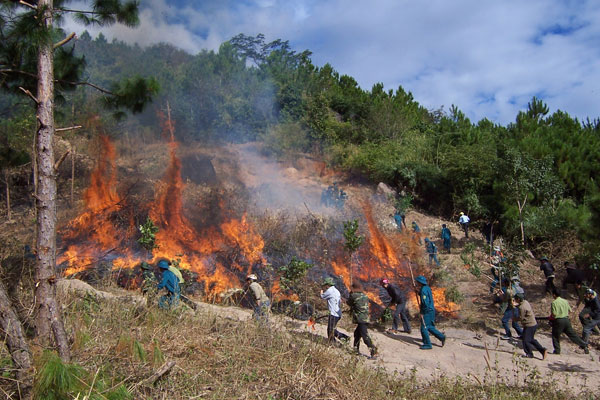Five Mekong sub-countries fight smog pollution
On February 29, in Hanoi, the second meeting of the sub-regional steering committee on the smog pollution across the border of the Mekong sub-region took place.
This conference was hosted by the Ministry of Agriculture and Rural Development of Vietnam, attended by representatives of 5 countries Thailand, Laos, Cambodia, Myanmar, Vietnam, and representatives of the ASEAN Secretariat.
Mr. Ha Cong Tuan, Deputy Director General of Vietnam Administration of Forestry affirmed that climate change, drought and natural disasters are happening more and more. Meanwhile, forests are identified as having a very important role in dealing with climate change. Therefore, countries in the Mekong sub-region and especially Vietnam need to strengthen comprehensive cooperation to protect and develop forests, deal with climate change.
Over the past years, Vietnam has made great efforts in forest protection and development, well implemented the motto of "on-the-spot" , socialized forest fire prevention and control, thus increasing the forest area. Significantly, the number of forest fires reduced, the forest coverage rate reached about 40%, contributing to reducing the pollution of haze.

Due to climate change, drought and natural disasters are happening more and more
In the coming years, Vietnam will reform institutional mechanisms and policies as well as increase human resources in forest protection and development, control forest fires, land fires, and strive for forest cover. reached 45%.
On behalf of the Technical Review Team on Transboundary Haze Pollution, Mr. Nguyen Huu Dung, Director of the Vietnam Forest Protection Department, said that in recent years, countries in the Mekong sub-region have had National action plan to manage haze in the dry season. Typically, Myanmar has implemented prevention and mitigation of forest fires, focusing on shifting cultivation, nomadic and nomadic farming; Cambodia strengthens training capacity building at district and commune levels; Vietnam also has many new policies on forest protection and development.
The countries in this region also increased coordination in the management of haze and fire, sharing information to conduct a regional forest fire warning system, as well as classifying fire hazard levels. . Thus, the objectives of fire and haze control in the Mekong sub-region have been basically completed. Hot spots on forest fires have decreased from 87,000 points in 2009 to 78,321 in 2011.
Delegates discussed and shared initiatives to mitigate soil fire, forest fire and control of haze pollution during the dry season this year; urgently build a system of early warning of regional fires; At the same time, it is also agreed to strive to implement well the target that by 2015 there will be no more than 50,000 hot spots on forest fires.
At the Conference, the ASEAN Secretariat representative also spoke about the progress of implementing cooperation projects with international partners such as the Peat Restoration and Sustainable Use Project in Southeast Asia. funded by the Global Environment Facility to promote sustainable management of peat lands in ASEAN to maintain local livelihoods, reduce the risk of fire and haze, and contribute to global environmental management; Sustainable management of peatland forests in Southeast Asia is supported by the European Union on peat lands for countries in the Mekong sub-region.
- The first summit about the Mekong
- Dust pollution in Beijing contains deadly poison
- Disaster management for the Lower Mekong countries
- No decision has been made on Lao hydroelectric dam
- Air pollution, smoke, eat to stay healthy?
- America participates in environmental protection downstream of the Mekong
- China decided to reduce car smoke to cope with pollution
- 'Should postpone dam construction on the Mekong for 10 years'
- The Mekong tiger may be extinct
- Startled, Vietnam is affected by mercury pollution from China?
- Map reveals the most polluted countries on the planet
- The whole Mekong Delta is subsiding at a rate of nearly 2.5cm per year
 Vietnam 5th Asian champion on fuel-efficient vehicles
Vietnam 5th Asian champion on fuel-efficient vehicles We can read all NASA studies completely free of charge
We can read all NASA studies completely free of charge Singer and songwriter Bob Dylan won the 2016 Nobel Prize for Literature
Singer and songwriter Bob Dylan won the 2016 Nobel Prize for Literature Scientific revolution in Asia
Scientific revolution in Asia Inside Hoia Baciu - The World's Scariest Forest
Inside Hoia Baciu - The World's Scariest Forest  145 million year old fossil cypress forest along the English coast
145 million year old fossil cypress forest along the English coast  40,000-year-old fossil forest discovered after storm
40,000-year-old fossil forest discovered after storm  Fascinating beauty of Hue mangrove forest in leaf changing season
Fascinating beauty of Hue mangrove forest in leaf changing season  Australia's primeval forests died en masse due to drought and climate change
Australia's primeval forests died en masse due to drought and climate change  Video: Close-up of catching a giant cobra 4.6m long
Video: Close-up of catching a giant cobra 4.6m long 